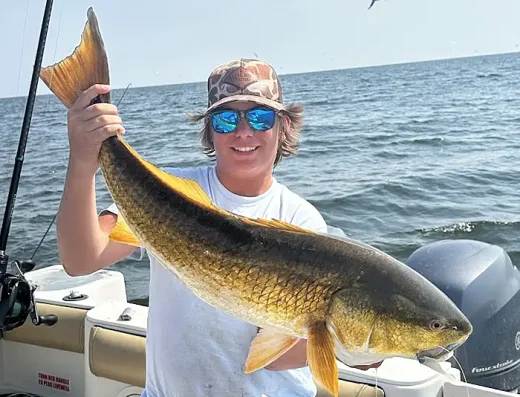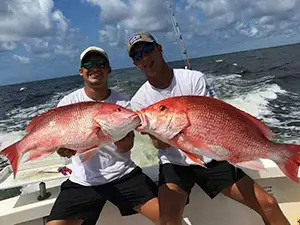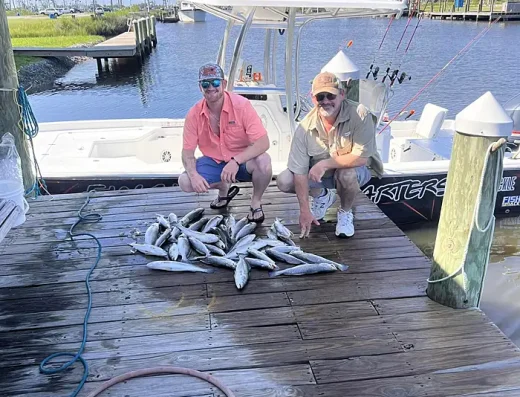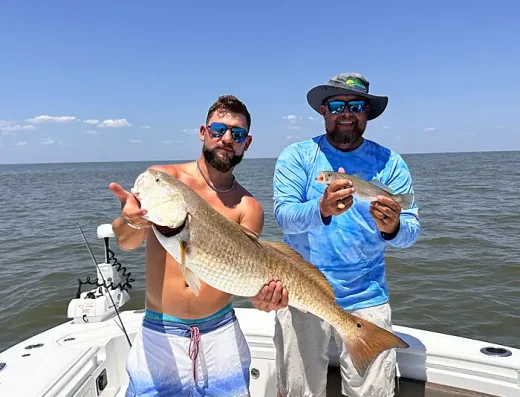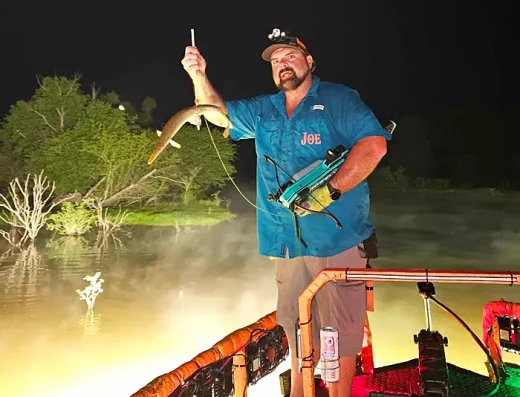Mississippi Fishing Charters
Mississippi fishing charters offer back-bay redfish runs, river catfish hauls, and deep Gulf trips for tuna and snapper.
TrustedFish connects anglers with proven local captains in Mississippi —no commissions, no pay-to-play listings, no BS. Every charter on our platform is invite-only, vetted for skill, local knowledge, and reputation. If they’re listed, they’ve earned it.
Top Rated Charters in Mississippi
Click to View Destinations
Mississippi Fishing Guide
Mississippi doesn’t have a massive coastline, but what it’s got is fishy. The inshore marshes, barrier islands, and sound waters between Biloxi and Pascagoula hold steady numbers of specks, reds, and black drum almost year-round. Backwater bayous and oyster-laden flats give light tackle anglers a lot to work with. Most inshore charters run half days, fishing live shrimp under popping corks or freelining pogies around drains and grass lines.
Offshore, boats launch out of Gulfport and Pass Christian, pushing 30–60 miles south to rigs and bottom spots in the Gulf. Snapper season draws big interest, but there’s also solid chances at kingfish, mahi, and blackfin tuna. Full-day trips cover most of it, especially if you’re chasing pelagics. If seas are calm, some captains will run to the deep rigs past the shelf for yellowfin.
Freshwater gets overlooked here, but rivers like the Mississippi, Pascagoula, and Pearl offer catfish, gar, and bream. Grenada and Sardis lakes in the north are crappie country—serious slab potential, especially in spring. A lot of locals fish from jon boats, but there are guided lake trips too.
The state’s barrier islands—Horn, Ship, Cat—help create calm inshore water, even when it’s blowing. Boat ramps are scattered throughout the coast, with big launches in Ocean Springs, Bay St. Louis, and the D’Iberville area. Bait shops are easy to find, and live shrimp usually gets the job done inshore. Offshore crews use cigar minnows, squid, and vertical jigs for bottom drops.
Regional Fishing Highlights
Coastal Marshes and Bayous
From Bay St. Louis east to Pascagoula, the inshore fishing holds steady with speckled trout, redfish, and flounder. These brackish waters are full of oyster reefs, grass banks, and tidal drains where fish ambush bait. Most guides run bay boats or flat-bottom skiffs, drifting or anchoring with live shrimp or croaker. Morning tides are best, especially on the edges of a cold front.
Gulf Islands and Nearshore Reefs
Horn Island, Ship Island, and the nearshore reef zones see action from Spanish mackerel, tripletail, and bull reds. You can usually reach these areas on a 4- to 6-hour charter. Tripletail float under debris and crab trap buoys in summer—tossing a live shrimp under a cork works well. The reefs also hold sheepshead and black drum in cooler months.
Deep Gulf Waters
Gulfport and Pass Christian are main jump-off points for offshore trips. Summer snapper runs are the headliner, but deeper water rigs and humps bring in mahi, amberjack, and blackfin. Full-day trips are standard. Trolling for kings early, then dropping squid or cut bait on structure is the usual plan. Some boats target yellowfin around deepwater rigs, but expect a long haul and an early start.
North Mississippi Lakes
Grenada, Sardis, and Enid lakes are top crappie destinations. Spider rigging in spring or casting jigs along timbered points works best. These flood-control reservoirs are wide open and exposed, so wind can be a factor. Most local guides run aluminum boats rigged with multiple rods and electronics dialed in on brush piles.
Fishing Seasons in Mississippi
Spring
Speckled trout and redfish fire up inshore as the water warms. Crappie in the north hit peak spawn mode, stacking in shallow flats and coves. Snapper season doesn’t open yet, but you can still catch sheepshead, black drum, and Spanish mackerel. Bayou drains and oyster beds are prime redfish spots on a falling tide.
Summer
Offshore is wide open—red snapper, kings, mahi, and tuna if you’re heading deep. Inshore trout spread across grass flats and barrier island cuts. Tripletail hang around floats and crab lines. Crappie push deep and slow down, but catfish bite well in the rivers. Early starts matter—heat and pop-up storms are a daily thing.
Fall
Best overall time to fish. Specks school up inshore, especially near mouths and cuts with moving water. Bull reds push into shallow bays. Offshore slows a bit, but you can still get kings and jacks. Catfish start feeding heavier in rivers. On calm days, tripletail can still be found offshore floating near debris.
Winter
Trout and redfish bunch up in deep bayous and channels. Slow presentations with soft plastics or live shrimp are key. Sheepshead stack on bridge pilings and reefs. Freshwater action shifts to deeper holes, with crappie hitting jigs slow-rolled near structure. Fewer crowds, but weather’s hit or miss.
Most Popular Gamefish in Mississippi
- Redfish – 18–40 inches. Found inshore near grass, drains, oyster beds. Live shrimp under corks or jigheads with soft plastics.
- Speckled Trout – 14–24 inches. Targeted inshore around flats, cuts, and shell bottom. Live bait or topwaters in low light.
- Tripletail – 5–25 pounds. Floaters near buoys and debris offshore. Sight-cast live shrimp under cork.
- Red Snapper – 5–20 pounds. Offshore reefs and rigs in summer. Cut bait or vertical jigs.
- Black Drum – 5–40 pounds. Deep bay channels, bridges, and reefs. Shrimp on bottom rigs.
- Flathead Catfish – 10–40 pounds. Mississippi River structure. Live bait near holes
- Crappie – 1–3 pounds. Northern lakes near structure. Jigs, minnows, spider rigs.
- Spanish Mackerel – 2–6 pounds. Nearshore reefs and rips. Fast trolled spoons or jigs.
- Blackfin Tuna – 15–30 pounds. Offshore rigs and rips. Trolled baits or chunking sardines.
Mississippi Fishing FAQs
What’s the best time to fish offshore in Mississippi?
Summer is prime—snapper season opens, and pelagics like kingfish, mahi, and tuna are more active. Calm weather helps too.
Where can I catch redfish near Biloxi?
Fish the marsh drains and oyster reefs near Point Cadet and around the Biloxi Bay bridges. Morning tides are best.
What kind of bait works best for inshore charters?
Live shrimp is the go-to, either under a popping cork or freelined. Some guides use croaker when targeting bigger trout.
Are Mississippi fishing charters good for kids?
Yes—especially inshore trips. Calm water, light tackle, and lots of action make them great for younger anglers.
How far offshore do charters usually go?
Snapper trips run 20–40 miles out. Deep water rigs for tuna or amberjack can be 60+ miles, so expect a full-day run.
Do charters fish around the barrier islands?
Yes—Horn, Ship, and Cat islands hold trout, reds, and tripletail depending on the season. They’re popular half-day runs.
Can I catch crappie in Mississippi?
Is the Mississippi River good for fishing?
It’s solid for catfish, especially flatheads and blues. Big fish live around current breaks, brush piles, and river bends.

